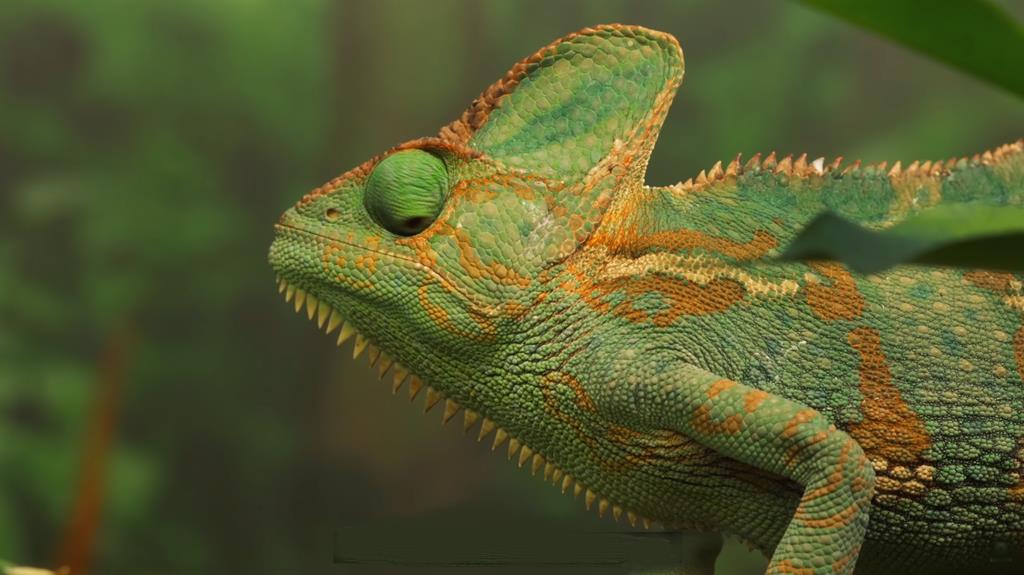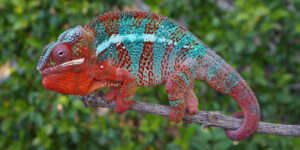Chameleons should sleep in a quiet, dark, and secure environment. They prefer to rest in a habitual spot within their enclosure, typically hanging from branches.
Understanding the sleeping habits of chameleons is critical for their overall well-being, as these creatures rely on a stable routine to maintain their health. As cold-blooded reptiles, they require particular temperature settings that do not drastically drop at night, to avoid stress and possible health issues.
A well-structured habitat with proper foliage and branches allows chameleons to find their comfortable sleeping position, enabling them to feel safe and relaxed throughout the night. Owners need to ensure that their pets have a consistent light-dark cycle, mimicking the chameleon’s natural habitat, to promote a healthy sleep pattern. Establishing a calming environment for a chameleon not only contributes to a good night’s sleep but also supports their intricate color-changing ability, which is less active during rest periods.
Chameleons And Sleep: The Basics
Understanding how chameleons sleep helps us create a comfortable habitat for our color-changing friends. Chameleons experience sleep differently from humans. Let’s explore the natural rhythms and environmental needs that ensure these unique reptiles get the rest they require.
Natural Sleep Cycles Of Chameleons
Chameleons, like most reptiles, follow a consistent sleep cycle. They are diurnal creatures, meaning they are active during the day and rest at night. As the sun sets, chameleons prepare to slow down their activity. They typically find a secure branch or leaf to settle on, tucking in their limbs to minimize their exposure. This position keeps them safe from predators while they sleep.
- Active in daylight
- Sleep at night
- Seek safe sleeping spots
The Significance Of Darkness In Chameleon Slumber
Darkness plays a crucial role in chameleon sleep patterns. These reptiles require an absence of light to fall into a deep slumber. Their enclosures should mimic natural light conditions to support their internal clocks. Ensure their environment is free from artificial lights at night, which allows them to maintain a healthy sleep cycle.
| Chameleon Sleep Requirement | Recommendation |
|---|---|
| Darkness | Turn off enclosure lights |
| Quiet Environment | Reduce noise levels at night |
Creating The Ideal Sleeping Environment
Chameleons, like all living creatures, need a tranquil and comfortable place to close their eyes at night. Creating The Ideal Sleeping Environment is essential for chameleons to ensure they’re well-rested, healthy, and happy. It’s just not about a dark spot; a proper habitat involves careful consideration of various factors from temperature to enclosure design.
Temperature Control For Nighttime Comfort
As night falls, keeping your chameleon cozy is vital. Chameleons require a specific temperature range to sleep well and maintain their health. An optimal range is slightly cooler than their daytime needs, usually between 65-70°F (18-21°C). Below are tips to maintain this temperature:
- Invest in a reliable digital thermometer.
- Use ceramic heaters or a low-wattage basking bulb if needed.
- Employ a thermostat to prevent temperature fluctuations.
Choosing The Right Enclosure For A Good Night’s Rest
The enclosure is your chameleon’s sanctuary. Selecting the right habitat is essential for good sleep. Here are key factors to consider:
| Feature | Requirement |
|---|---|
| Size | At least 18x18x36 inches for most species |
| Material | Non-toxic, well-ventilated like a mesh enclosure |
| Accessibility | Doors that allow easy access without startling |
Ensure daily maintenance like removing leftover food and providing fresh water. Keep the enclosure clean and secure for peaceful chameleon slumbers.
The Impact Of Lighting On Chameleon Sleep
Understanding how chameleons sleep is key to their well-being. Light plays a crucial role in their sleep patterns. As the sun sets, chameleons prepare for rest. But what happens when artificial light disrupts this natural cycle? Let’s explore the effects of various lighting conditions on chameleon sleep and what we can do to encourage healthy sleep behaviors in these colorful creatures.
Artificial Light Exposure And Sleep Disruption
Like humans, chameleons need darkness to sleep well. Artificial lights can confuse their internal clocks. This may lead to stress and health issues. Chameleons exposed to excessive artificial light might:
- Show signs of stress
- Eat less
- Experience disrupted sleep patterns
Lights off is the mantra for chameleon bedtime.
Proactive Light Management Strategies
Creating a comfortable sleep environment for chameleons is crucial. Managing light effectively can make a big difference. Consider these strategies:
- Set a light schedule that mimics natural sunrise and sunset.
- Use a timer for your chameleon’s lights.
- Darken the room to encourage natural sleep behaviors.
These steps can promote restful sleep for your chameleon, helping them stay happy and healthy.
Diet And Sleep Quality In Chameleons
The right diet is crucial for a chameleon’s health and well-being, playing a significant role in its sleep quality. Like humans, chameleons need balanced nutrition to function well, and this includes getting adequate rest. In this section, we explore how diet impacts sleep and the best feeding schedules to promote restful nights.
How Nutritional Habits Affect Rest
A chameleon’s diet can significantly influence its sleep patterns. A well-fed chameleon is typically more relaxed and can sleep better. Here are key points:
- Calcium is essential for neuromuscular health, impacting sleep quality.
- Vitamins, particularly A and D3, play roles in regulating sleep cycles.
- Water intake matters, as dehydration can cause sleep disturbances.
Feeding Schedules That Promote Healthy Sleep Patterns
For chameleons to have a restful sleep, consistent feeding times are key. Consider these guidelines:
- Feed early in the day to allow digestion before nightfall.
- Stick to a routine; erratic feeding can lead to stress and poor sleep.
- Provide a light evening snack, if needed, for young chameleons that require more frequent meals.
By acknowledging the importance of a balanced diet and a regular feeding schedule, you can aid your chameleon in getting the restorative sleep it needs to thrive.
Addressing Common Sleep Disturbances
Addressing Common Sleep Disturbances is crucial for the health of chameleons. In their natural habitat, chameleons sleep without the disruptions often found in captivity. Adjusting their environment can promote a restful sleep, essential for their well-being. Let’s explore the signs that indicate sleep issues and ways to provide a disturbance-free sleep zone for these colorful creatures.
Identifying Signs Of Sleep Issues
Chameleon owners might notice certain behaviors that signal sleep disturbances. Recognizing these signs is the first step to ensure your chameleon gets the rest it needs. Common sleep issues include:
- Restlessness during the night.
- Frequent waking or unusual activity after dark.
- Daytime lethargy, signaling insufficient sleep.
Interventions To Ensure Uninterrupted Sleep
To help your chameleon achieve uninterrupted sleep, consider these interventions:
- Dim the lights: Chameleons need dark, calm environments to sleep properly.
- Maintain a consistent day/night cycle: This mimics their natural habitat and helps regulate their sleep patterns.
- Minimize noise: Keep sounds low to avoid waking your chameleon.
- Adjust temperature: Ensure that nighttime temperatures align with their natural conditions.
- Offer proper enclosure: A comfortable and safe space can greatly improve sleep quality.
Monitoring Your Chameleon’s Sleep Health
Understanding how chameleons sleep is key to ensuring they stay healthy and happy. Like other living creatures, chameleons need quality rest. Observing their sleep patterns reveals much about their well-being.
Regular Sleep Observations And Insights
Monitoring sleep schedules in chameleons is crucial. They are typically nocturnal sleepers. Here are some points to note:
- Dark and cool environments aid in chameleons’ sleep.
- They prefer sleeping off the ground, nestled in branches.
- Lights should be off for 10-12 hours to mimic natural conditions.
- Irregular sleeping patterns may indicate stress or illness.
Take note of your chameleon’s usual sleeping spot. Sudden changes might be a sign of a problem.
When To Consult A Veterinarian
If your chameleon shows signs of disturbed sleep, it might be time to see a vet. Watch for these indicators:
- Excessive sleep during the day.
- Falling off their sleeping perch.
- Difficulty closing eyes, or swelling around them.
- Changes in skin coloration that persist into rest.
A professional can assess if these signs point to issues like infections or dietary deficiencies.
Remember, creating a calm sleeping environment and regular monitoring are your best tools to ensure your chameleon’s health. With careful observation, you’ll soon become a pro at recognizing your pet’s sleep needs and habits.
Frequently Asked Questions On How Should Chameleons Sleep?
How Do Chameleons Sleep?
Chameleons sleep by finding a secure perch, often in trees or shrubs, where they can rest safely through the night. They typically assume a still, settled posture and may exhibit color changes to blend with their surroundings while they sleep.
Are Chameleons Supposed To Sleep During The Day?
No, chameleons are diurnal, meaning they are active during the day and sleep at night. Daytime sleeping could indicate health issues.
How Do You Know If A Chameleon Is Relaxed?
A relaxed chameleon typically has a calm demeanor, exhibiting steady, regular breathing, settled limbs, and a uniform, often brighter coloration. Its eyes move slowly, scanning the surroundings without rapid jerking movements.
Can Chameleons Sleep With The Light On?
Chameleons prefer darkness to sleep and may become stressed with the light on. They need a dark environment at night for proper rest.
Conclusion
Understanding the ideal sleep conditions for chameleons is crucial to their well-being. These adaptive creatures require specific environments to ensure healthy rest. Tailored lighting, temperature control, and habitat mimicry play pivotal roles. By meeting these needs, we ensure our colorful friends thrive, night after peaceful night.
Keep these tips in mind for a happy, rested chameleon.


